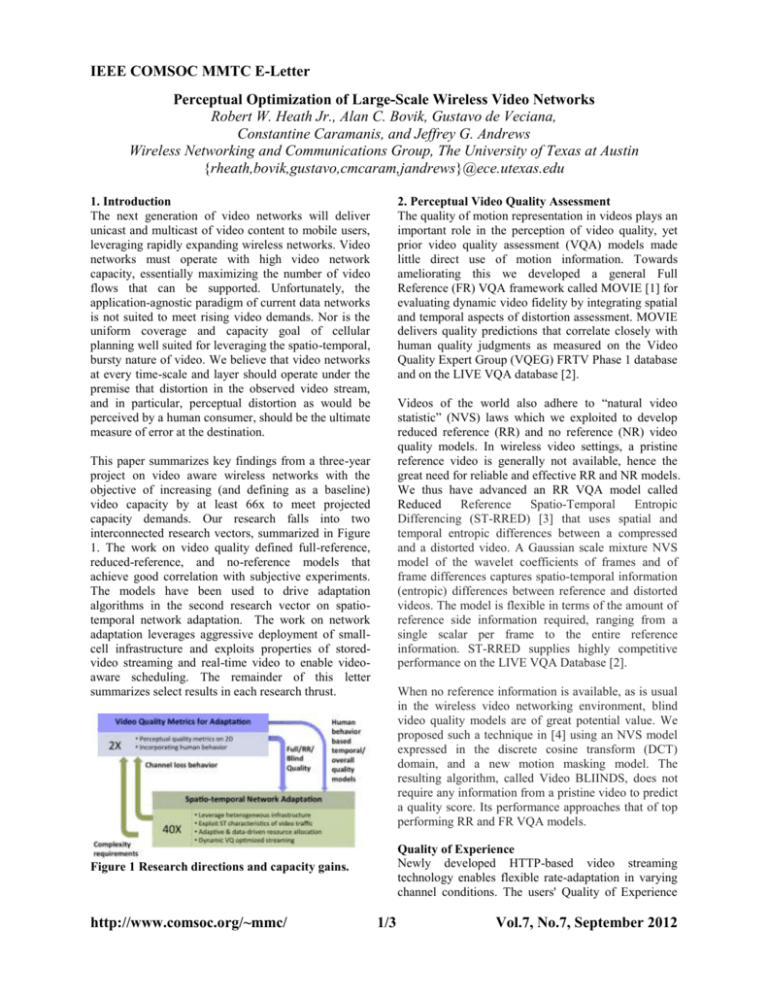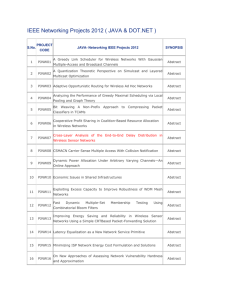IEEE COMSOC MMTC E-Letter IEEE COMSOC MMTC E
advertisement

IEEE COMSOC MMTC E-Letter
Perceptual Optimization of Large-Scale Wireless Video Networks
Robert W. Heath Jr., Alan C. Bovik, Gustavo de Veciana,
Constantine Caramanis, and Jeffrey G. Andrews
Wireless Networking and Communications Group, The University of Texas at Austin
{rheath,bovik,gustavo,cmcaram,jandrews}@ece.utexas.edu
1. Introduction
The next generation of video networks will deliver
unicast and multicast of video content to mobile users,
leveraging rapidly expanding wireless networks. Video
networks must operate with high video network
capacity, essentially maximizing the number of video
flows that can be supported. Unfortunately, the
application-agnostic paradigm of current data networks
is not suited to meet rising video demands. Nor is the
uniform coverage and capacity goal of cellular
planning well suited for leveraging the spatio-temporal,
bursty nature of video. We believe that video networks
at every time-scale and layer should operate under the
premise that distortion in the observed video stream,
and in particular, perceptual distortion as would be
perceived by a human consumer, should be the ultimate
measure of error at the destination.
2. Perceptual Video Quality Assessment
The quality of motion representation in videos plays an
important role in the perception of video quality, yet
prior video quality assessment (VQA) models made
little direct use of motion information. Towards
ameliorating this we developed a general Full
Reference (FR) VQA framework called MOVIE [1] for
evaluating dynamic video fidelity by integrating spatial
and temporal aspects of distortion assessment. MOVIE
delivers quality predictions that correlate closely with
human quality judgments as measured on the Video
Quality Expert Group (VQEG) FRTV Phase 1 database
and on the LIVE VQA database [2].
Videos of the world also adhere to “natural video
statistic” (NVS) laws which we exploited to develop
reduced reference (RR) and no reference (NR) video
quality models. In wireless video settings, a pristine
reference video is generally not available, hence the
great need for reliable and effective RR and NR models.
We thus have advanced an RR VQA model called
Reduced
Reference
Spatio-Temporal
Entropic
Differencing (ST-RRED) [3] that uses spatial and
temporal entropic differences between a compressed
and a distorted video. A Gaussian scale mixture NVS
model of the wavelet coefficients of frames and of
frame differences captures spatio-temporal information
(entropic) differences between reference and distorted
videos. The model is flexible in terms of the amount of
reference side information required, ranging from a
single scalar per frame to the entire reference
information. ST-RRED supplies highly competitive
performance on the LIVE VQA Database [2].
This paper summarizes key findings from a three-year
project on video aware wireless networks with the
objective of increasing (and defining as a baseline)
video capacity by at least 66x to meet projected
capacity demands. Our research falls into two
interconnected research vectors, summarized in Figure
1. The work on video quality defined full-reference,
reduced-reference, and no-reference models that
achieve good correlation with subjective experiments.
The models have been used to drive adaptation
algorithms in the second research vector on spatiotemporal network adaptation. The work on network
adaptation leverages aggressive deployment of smallcell infrastructure and exploits properties of storedvideo streaming and real-time video to enable videoaware scheduling. The remainder of this letter
summarizes select results in each research thrust.
When no reference information is available, as is usual
in the wireless video networking environment, blind
video quality models are of great potential value. We
proposed such a technique in [4] using an NVS model
expressed in the discrete cosine transform (DCT)
domain, and a new motion masking model. The
resulting algorithm, called Video BLIINDS, does not
require any information from a pristine video to predict
a quality score. Its performance approaches that of top
performing RR and FR VQA models.
Quality of Experience
Newly developed HTTP-based video streaming
technology enables flexible rate-adaptation in varying
channel conditions. The users' Quality of Experience
Figure 1 Research directions and capacity gains.
http://www.comsoc.org/~mmc/
1/3
Vol.7, No.7, September 2012
IEEE COMSOC MMTC E-Letter
(QoE) of rate-adaptive HTTP video streams, however,
is not well understood. Therefore, designing QoEoptimized rate-adaptive video streaming algorithms
remains a challenging task. An important aspect of
understanding and modeling QoE is to be able to
predict the up-to-the-moment subjective quality of
video as it is played. In [5], we propose a dynamic
system model to predict the time-varying subjective
quality of rate-adaptive videos transported over HTTP.
The new model effectively predicts the time-varying
subjective quality of rate-adaptive videos in an online
manner, making it possible to conduct QoE-optimized
online rate-adaptation for HTTP-based video streaming.
dynamics and the rate-quality characteristics. For the
wireless cellular downlink with fixed number of users,
the algorithm is asymptotically optimal. Capacity gains
with the proposed algorithm are in the range of 2x.
Scalable Video Adaptation
Scalable video provides a flexible rate-adaptation
method for varying wireless channel conditions.
Designing scalable video scheduling algorithms for
wireless channels, however, is a complex task. The
scheduling policy depends not only on the channel
conditions, but also on the receiver buffer state. In [11],
we propose a scheduling algorithm that seeks to
optimize the average quality of scalably coded videos
(measured by multiscale SSIM [12]) that have been
stored at a video server before transmission. The
algorithm is developed under a Markov decision
process (MDP) formulation. We model the dynamics
of the channel as a Markov chain and reduce the
problem of dynamic video scheduling to a tractable
Markov decision problem over a finite-state space.
Simulation results show that the performance of the
scheduling algorithm is close to a performance upper
bound also derived in [13], yielding an approximate 2x
capacity gain.
A New Mobile Video Quality Database
Reference databases with mean opinion scores are
important to allow researchers to compare competing
VQA algorithms. We built a database of rate-varying
video sequences called the LIVE Mobile Video Quality
Database that simulate quality fluctuations commonly
encountered in video streaming applications [6], [7].
We conducted a large scale subjective study on which
time-varying subjective judgments of video quality
were collected using two types/sizes of wireless display
devices (smartphone and tablet). We envision that this
free, publicly available database will prove useful for
developing and validating visual quality models for
quality-varying long videos.
MIMO Video Adaptation
In [13], we introduce an architecture for real-time
video transmission over multiple-input multiple-output
(MIMO) wireless communication systems using loss
visibility side information of video packets. To jointly
capture video quality and network throughput, we
define the optimization objective as the throughput
weighted by the loss visibility of each packet, a metric
coined perceived throughput. We use the loss visibility
side information to classify video packets and transmit
them through different subchannels of the MIMO
channel. When tested on H.264-encoded video
sequences, the proposed architecture achieves the same
video quality (SSIM [14]) at a 17 dB reduction in
transmit power for a 2x2 MIMO system, giving a 2-4x
capacity gain over a baseline MIMO system.
3. Spatio Temporal Interference Management
Interference Shaping for Improved Quality of
Experience for Real-Time Video Streaming
Bursty co-channel interference is a prominent cause of
wireless throughput variability, which leads to
annoying video quality variations. In [8], we propose
and analyze a network-level resource management
algorithm termed interference shaping to smooth video
quality variations, by decreasing the peak rate of cochannel best effort users. The proposed algorithm is
designed to maximize the H-MS-SSIM index [9],
which incorporates a hysteresis (or ‘recency’) effect in
predicting the perceived video quality. The proposed
technique increases mean video quality and reduces the
quality variations over time, with a net perceptual
increase of about 2-3x.
4. Conclusions
In this paper we summarized some of our recent work
on developing new models for perceptual video quality
assessment, and using these models to adapt video
transmission based on perceptual distortion. Our
adaptive algorithms give capacity gains on the order of
2-4x depending on the definition of capacity and the
baseline. A major finding not discussed here is that
capacity gains of 40x or more could be achieved
through aggressive deployment of small-cell
infrastructure [15]. These capacity gains come on top
of the other gains from adaptive algorithms. In further
work, we are developing models that better describe
Multi-User Rate Adaptation for Stored Video
Transport Over Wireless Systems
It has long been recognized that frequent video quality
fluctuations could significantly degrade the QoE, even
if the average video quality is high. In [10], we develop
an online multi-user rate-adaptation algorithm to
maximize the weighted sum of average quality and
quality variations. The algorithm only requires minimal
statistical information about the wireless channel
http://www.comsoc.org/~mmc/
2/3
Vol.7, No.7, September 2012
IEEE COMSOC MMTC E-Letter
[11] C. Chen, R.W Heath, Jr., A.C. Bovik and G. de Veciana,
“A Markov decision model for adaptive scheduling of
stored scalable videos,” IEEE Trans. Circ. Syst., Video
Technol., vol.23, no.6, pp. 1081-1095, June 2013.
[12] Z. Wang, E. Simoncelli and A.C. Bovik, “Multi-scale
structural similarity for image quality assessment,”
Asilomar Conf. Signals, Syst, Comput., Pacific Grove,
CA, Nov. 2003.
[13] A.A. Khalek, C. Caramanis, and R.W. Heath, Jr., “Loss
visibility optimized real-time video transmission over
MIMO systems,” IEEE Trans. Circ. Syst., Video
Technol., submitted.
[14] Z Wang, A.C. Bovik, H.R. Sheikh and E.P. Simoncelli,
“The SSIM index for image quality assessment,” Online:
http://www.cns.nyu.edu/~ lcv/ssim.
[15] XXX Jeff HetNet type paper
the quality of experience and using these models to
develop more advanced algorithms.
Acknowledgements
This work is supported by the Intel-Cisco Video Aware
Wireless Networks (VAWN) Program.
References
[1] K. Seshadrinathan and A.C. Bovik, “Motion-tuned spatiotemporal quality assessment of natural videos,” IEEE
Trans. Image Process., vol. 19, no. 2, pp. 335-350, Feb.
2010.
[2] K. Seshadrinathan, R. Soundararajan, A. C. Bovik, and L.
K. Cormack, “Study of subjective and objective quality
assessment of video,” IEEE Trans. Image Process., vol.
19, no. 6, pp. 1427–1441, Jun. 2010.
[3] R. Soundararajan and A.C. Bovik, “Video quality
assessment by reduced reference spatio-temporal entropic
differencing,” IEEE Trans. Circ. Syst., Video Technol.,
vol. 23, no. 4, pp. 684-694, April 2013.
[4] M.A. Saad and A.C. Bovik, “Blind prediction of natural
video quality,” IEEE Trans. Image Process, in revision.
[5] C. Chen, L.K. Choi, G. de Veciana, C. Caramanis, R.W.
Heath, Jr., and A. C. Bovik, “A dynamic system model of
time-varying subjective quality of video streams over
HTTP ,” IEEE Int’l Conf Acoust, Speech Signal Process,
Vancouver, British Columbia, May 2013.
[6] A.K. Moorthy, L.K. Choi, A.C. Bovik and G. de Veciana,
“Video quality assessment on mobile devices: Subjective,
behavioral, and objective studies,” IEEE J. Sel Topics
Signal Process., Special Issue on New Subjective and
Objective Methodologies for Audio and Visual Signal
Processing, vol. 6, no. 6, pp. 652-671, Oct. 2012.
[7] A.K. Moorthy, L.K. Choi, A.C. Bovik and G. DeVeciana,
LIVE Mobile Video Quality Database. Online:
http://live.ece.utexas.edu/research/quality/live_mobile_vi
deo.html.
[8] S. Singh, J.G. Andrews, G. de Veciana, “Interference
shaping for improved quality of experience for real-time
video streaming,” IEEE J. Sel. Areas in Commun., vol.30,
no.7, pp. 1259-1269, Aug. 2012.
[9] K. Seshadrinathan and A.C. Bovik, “Temporal hysteresis
model of time-varying subjective video quality,” IEEE
Int’l Conf. Acoust., Speech Signal Process, May 22-27,
Prague, Czech Republic, 2011.
[10] V. Joseph and G. de Veciana, “Jointly optimizing multiuser rate adaptation for video transport over wireless
systems: Mean-fairness-variability tradeoffs,” IEEE
INFOCOM, March 2012.
http://www.comsoc.org/~mmc/
Robert W. Heath Jr. is a Professor in the ECE
Department at UT Austin. He received the Ph.D. in EE
from Stanford University. He is the recipient of the
David and Doris Lybarger Endowed Faculty
Fellowship in Engineering, is a
registered Professional Engineer in
Texas, and is a Fellow of the IEEE.
Alan C. Bovik. See photo and biosketch
in another letter in this issue.
Gustavo de Veciana is a Professor in the ECE
Department at UT Austin. He received the Ph.D. in
EECS from U.C. Berkeley. He is currently the
recipient of the Joe J. King Endowed Professorship in
Engineering, and a Fellow of the IEEE.
Constantine Caramanis is an Associate
Professor in the ECE Department at UT
Austin…
Jeffrey G. Andrews is a Professor in the
ECE Department at UT Austin….
3/3
Vol.7, No.7, September 2012






